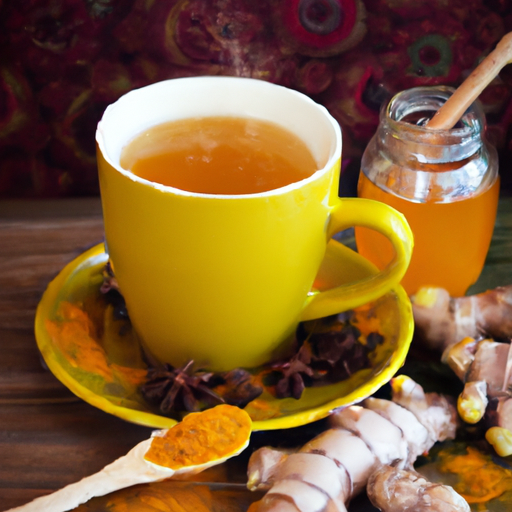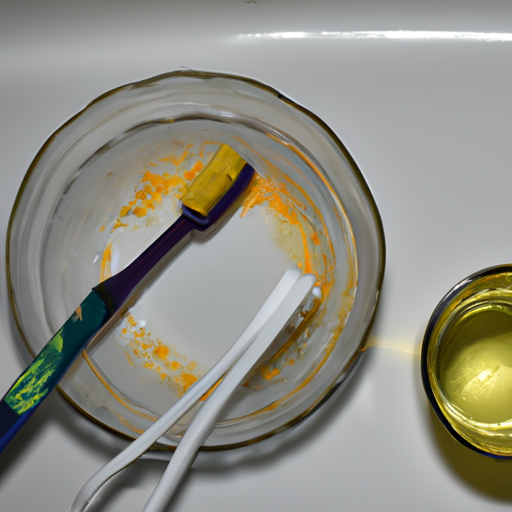Hello! I’m thrilled to share my top recipe for ginger turmeric tea with you. This cozy and delightful beverage is not only flavorful, but it’s also packed with numerous health advantages.
Ginger and turmeric are two powerful anti-inflammatory plants that have been used for centuries in traditional medicine. When combined into a tea, they can help alleviate pain, reduce inflammation, boost immunity, aid digestion, and even improve brain function.
Plus, drinking a cup of ginger turmeric tea is a great way to unwind at the end of the day or start your morning off on the right foot.
So let’s get started!
Key Takeaways
- Ginger and turmeric are powerful anti-inflammatory plants used in traditional medicine for centuries.
- When combined into a tea, they can alleviate pain, reduce inflammation, boost immunity, aid digestion, and improve brain function.
- Incorporating these two ingredients into your diet can improve digestive health, boost immunity, and reduce inflammation.
- Making ginger turmeric tea involves boiling 2 cups of water, adding ginger, turmeric, black pepper, lemon, and sweetener, steeping for 5 minutes, and adding plant-based milk for creaminess.
The Health Benefits of Ginger Turmeric Tea
You’re in for a treat with this tea – not only does it taste delicious, but the ginger and turmeric also offer amazing health benefits to keep you feeling great!
Ginger and turmeric are two of the most powerful spices when it comes to promoting good health. They have been used for centuries in traditional medicine to treat a variety of ailments, from digestive issues to inflammation.
Recipes for using ginger and turmeric in cooking are numerous, but drinking them together as a tea is an easy way to incorporate these spices into your daily routine. Ginger has long been known for its ability to soothe upset stomachs and reduce nausea. It’s also been shown to have anti-inflammatory properties, making it helpful in reducing pain associated with conditions like arthritis.
Turmeric is another spice that has been used medicinally for thousands of years. Its active ingredient, curcumin, has powerful antioxidant and anti-inflammatory effects that can help protect against chronic diseases like heart disease and cancer. Adding turmeric to your diet may even improve brain function by boosting levels of brain-derived neurotrophic factor (BDNF), a protein responsible for supporting healthy brain cells.
Now that you know about the health benefits of ginger turmeric tea, let’s move on to the ingredients needed to make this delicious drink!
Ingredients Needed to Make Ginger Turmeric Tea
To prepare this delicious beverage, all you need are a few simple ingredients that can be easily found in your kitchen. Don’t worry if you don’t have fresh ginger or turmeric on hand, powdered versions work just as well and still provide the same health benefits. The main ingredients needed for making ginger turmeric tea include ginger root, turmeric root or powder, water, and optional sweeteners like honey or maple syrup.
Ginger and turmeric have been used in traditional medicine for centuries due to their powerful anti-inflammatory properties. Incorporating these two ingredients into your diet can help improve digestive health, boost immunity and reduce inflammation. In addition to its numerous health benefits, ginger turmeric tea is also incredibly tasty and versatile. You can experiment with different variations of flavors by adding other herbs like cinnamon or cardamom.
If you’re looking to reap the benefits of ginger and turmeric in other recipes, try adding them to smoothies or soups for an extra kick of flavor and nutrition. As for variations of ginger turmeric tea flavors, there are endless possibilities! For a refreshing twist on classic ginger turmeric tea, add some mint leaves or lemon juice. If you prefer a creamier texture, mix in some coconut milk or almond milk.
Now that we know what ingredients we need for making this wonderful beverage let’s move on to preparing the ginger and turmeric roots!
Preparing the Ginger and Turmeric
First, peel the knobby ginger root and slice it into thin pieces, then do the same for the vibrant orange turmeric root, being careful not to stain your hands.
I always make sure to choose fresh ingredients when preparing my ginger turmeric tea. The roots should feel firm to the touch and have a bright color.
Once both roots are sliced, I use a grating technique to further break down the fibers of each root. This technique helps release more flavor and nutrients from the roots when brewed in hot water. I find that using a microplane grater works best for this step.
Now that our ginger and turmeric are prepared, we can move on to boiling some water and adding these ingredients. But first, let’s take a moment to appreciate how simple yet powerful these two ingredients can be when combined together in one delicious cup of tea.
Boiling the Water and Adding the Ingredients
Now it’s time to get that water boiling and add in those powerful ingredients for a cup of tea that’ll knock your socks off! Boiling techniques are key when preparing any type of tea, and ginger turmeric tea is no exception.
Start by bringing 2 cups of water to a boil in a pot on the stove or using an electric kettle. Once the water reaches boiling point, take it off the heat source and pour it into your teapot or mug.
Now comes the fun part – adding in the ingredients that’ll give your tea its unique flavor and health benefits. Here are five items to include:
- A tablespoon of grated fresh ginger
- A teaspoon of grated fresh turmeric
- A dash of black pepper (to help with turmeric absorption)
- A slice of lemon or squeeze of lemon juice
- Honey or maple syrup to taste
To make sure all these ingredients are fully infused into your tea, you can use a tea infuser ball or strainer. Let everything steep for about 5 minutes before removing the infuser/strainer.
Adding these simple yet powerful ingredients to your boiling water will create a delicious and healthy ginger turmeric tea that you’ll want to enjoy every day.
As we move on to straining and serving the tea, you’ll see how easy it is to create this plant-based beverage at home.
Straining and Serving the Tea
Once the ingredients have steeped for 5 minutes, it’s time for me to strain the tea and serve it hot with a slice of lemon or a drizzle of honey to my liking.
To strain the tea, I use a fine-mesh strainer and pour the tea into my favorite mug. This removes any ginger or turmeric bits that may have been left behind during steeping.
When serving the ginger turmeric tea, there are many techniques one can use to enhance its flavor profile. For example, adding a splash of plant-based milk such as almond milk can add creaminess to the tea. Additionally, pairing this spicy and earthy tea with some light snacks like roasted almonds or dark chocolate can make for an enjoyable experience.
Incorporating different herbs and spices into your ginger turmeric tea can also elevate its taste profile.
In the next section about tips for customizing your ginger turmeric tea, I’ll share some ideas on how you can experiment with different flavors to create your own signature blend!
Tips for Customizing Your Ginger Turmeric Tea
To add your own unique twist to this golden elixir, you can sprinkle in a variety of herbs and spices like a chef adding special ingredients to their signature dish, creating a symphony of flavors that dance on your taste buds like fireworks in the night sky.
Flavor variations are endless when it comes to ginger turmeric tea. You can add lemon or orange zest for a citrusy kick or use honey instead of sugar for sweetness. Herbal additions also make great flavor enhancers. Fresh mint leaves, rosemary sprigs, and basil leaves all bring different tastes to the table. Cinnamon sticks and cardamom pods add warmth and depth while black pepper adds a little spice.
Don’t be afraid to experiment with different combinations until you find your perfect blend. Once you’ve found your ideal flavor profile, store any leftover ginger turmeric tea in an airtight container in the fridge for up to three days. When you’re ready to enjoy it again, simply reheat on the stove or drink it cold over ice.
With just a few extra touches here and there, you can elevate this already delicious drink into something truly magical.
Storing Leftover Ginger Turmeric Tea
If you have any leftover ginger turmeric tea, remember to store it in an airtight container in the fridge for up to three days so you can enjoy it again later. The key to storing tea is ensuring that it remains fresh and flavorful. Therefore, it’s important to keep your tea away from heat, light, and moisture.
The shelf life of ginger turmeric tea depends on how well you store it. If stored properly, your tea can last for up to three days without losing its flavor or aroma. However, if you notice any changes in taste or smell after the third day, it’s time to discard the remaining tea.
Incorporating ginger and turmeric into your daily routine is a great way to boost your overall health and wellness. In addition to making tea with these two powerful ingredients, there are other ways to use them in recipes such as smoothies, soups, or curries.
Other Ways to Use Ginger and Turmeric
Now that you know how to store leftover ginger turmeric tea, let’s explore other ways to use these two powerful ingredients in your cooking. Ginger and turmeric are versatile spices that can be used in a variety of dishes and cooking methods.
Here are some ideas for incorporating ginger and turmeric into your meals:
| Ginger | Turmeric |
|---|---|
| Stir-fry dishes | Curry powder |
| Tea or smoothie flavoring | Rice seasoning |
| Baked goods (gingerbread, cookies) | Roasted vegetables |
| Marinades for meat or tofu | Salad dressings |
It’s important to note that while ginger and turmeric have numerous health benefits, they may also have potential side effects. For example, consuming large amounts of ginger can cause heartburn or stomach upset, while high doses of turmeric may lead to gastrointestinal issues or interfere with blood clotting medication.
As with any ingredient, it’s best to use moderation and consult with a healthcare professional if you have any concerns about incorporating ginger and turmeric into your diet. With these precautions in mind, let’s move on to the next section about safe usage of these herbs in our daily lives.
Precautions When Using Ginger and Turmeric
It’s important to be aware of potential side effects when incorporating ginger and turmeric into your diet, as they can have both health benefits and risks. While these spices are generally considered safe for most people, consuming them in large amounts or for prolonged periods may cause adverse reactions.
One common issue is gastrointestinal discomfort, including nausea, bloating, and diarrhea. This is especially true if you consume ginger or turmeric on an empty stomach or in high doses. To avoid these symptoms, start with small amounts and gradually increase the dosage as your body adjusts.
In addition to digestive issues, some people may experience allergic reactions to ginger or turmeric. Symptoms can range from mild (skin rash) to severe (anaphylaxis), so it’s crucial to watch for any signs of a reaction when trying out new recipes.
If you have a history of allergies or are taking medication that interacts with these spices, it’s best to consult with your healthcare provider before adding them to your diet.
Frequently Asked Questions
Can ginger turmeric tea help with weight loss?
Ginger turmeric tea is a delicious and natural way to boost your metabolism and aid in weight loss. The benefits of this powerful combination include reducing inflammation, improving digestion, and increasing energy levels.
To make the tea, simply mix powdered ginger and turmeric with hot water and honey for taste. It’s important to note that while there are many health benefits to drinking this tea, it should be consumed in moderation as excessive dosage can lead to side effects such as headaches or migraines.
Additionally, pregnant women should consult their doctor before consuming ginger turmeric tea. Overall, incorporating this plant-based drink into your daily routine can provide numerous health benefits and help promote a natural approach to wellness.
Is it safe to consume ginger turmeric tea while pregnant?
As someone who’s pregnant, I’ve done my research on consuming ginger turmeric tea during pregnancy. While ginger and turmeric have anti-inflammatory properties and potential weight loss benefits, caution is necessary. Some studies suggest that high doses of turmeric may stimulate contractions, leading to preterm labor or miscarriage. Ginger may also interact with certain medications used during pregnancy. It’s best to consult with your healthcare provider before incorporating new herbs or supplements into your diet while pregnant.
How often should I drink ginger turmeric tea to see health benefits?
I know what you’re thinking – ‘How often do I really need to drink ginger turmeric tea to see any benefits?’
Well, let me tell you that the benefits of drinking ginger turmeric tea are numerous and varied. It can help reduce inflammation, boost your immune system, aid in digestion, and even improve cognitive function.
Studies have shown that consuming as little as one cup per day can provide these health benefits. However, it’s important to note that everyone’s body is different and may react differently to the tea.
As a general guideline, 2-3 cups per day is recommended for maximum health benefits. So why not give it a try? Incorporating this natural and plant-based remedy into your daily routine could be just what your body needs!
Can I use powdered ginger and turmeric instead of fresh?
Yes, you can definitely use powdered ginger and turmeric instead of fresh when making your ginger turmeric tea. In fact, using powdered versions of these wonderful spices can be a great way to enjoy the benefits they offer without sacrificing taste or convenience.
There are many different recipe variations you can try when making this tea with powdered ingredients, so feel free to experiment and find the perfect blend that works best for your taste buds and health goals. Whether you’re looking to boost your immune system, reduce inflammation in the body, or simply enjoy a warm and comforting beverage, adding powdered ginger turmeric to your tea is a fantastic way to do just that!
Can ginger turmeric tea help with headaches or migraines?
I’ve found that ginger turmeric tea can be a helpful remedy for headaches and migraines. The benefits of this tea come from the anti-inflammatory properties of both ginger and turmeric, which can help to reduce the inflammation in the body that may be contributing to these conditions.
When brewing this tea, I like to use fresh ginger and turmeric roots, but powdered versions can work as well. To make the most potent brew, I recommend simmering the roots in water for at least 10 minutes before straining and enjoying.
Overall, incorporating ginger turmeric tea into your daily routine may provide relief for headaches and migraines while also promoting overall wellness through its many other health-boosting properties.
Conclusion
In conclusion, ginger turmeric tea is a delicious and healthy way to incorporate these powerful superfoods into your daily routine. Not only does it have numerous health benefits such as reducing inflammation and aiding digestion, but it also provides a warming and comforting sensation that can help soothe the mind and body.
For example, my friend Sarah suffered from chronic pain due to arthritis. She started drinking ginger turmeric tea every day for several weeks and noticed a significant reduction in her joint pain. It allowed her to move more freely without relying on medication.
By incorporating this simple recipe into your life, you can experience the many benefits of ginger and turmeric too. So take some time to prepare a cup of this nourishing tea, sit back, relax, and enjoy!










